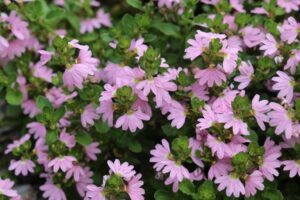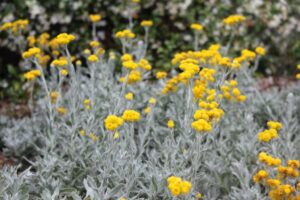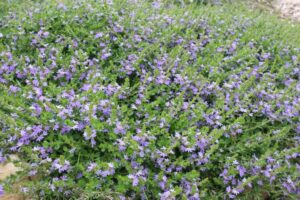High performance Australian wildflowers
By Daniel Fuller
During my educational webinar sessions with landscape architects and designers, I’ve noticed an increasing desire to use wildflowers, but plant performance has been an issue in the past. Many of Australia’s most spectacular flowering plants tend to put on vibrant displays for a short period and then quickly roll over at the first sign of heat, drought, flooding, or frost. We’ve recognised this opportunity and have bred a number of wildflowers, with tougher roots and rhizomes, that are more resilient.
Australian wildflowers have an interesting ecological strategy – live fast, reproduce, and die young. We don’t generally have native annual plants like they do overseas, because it doesn’t usually get cold enough. Instead, we have a lot of showy ‘ephemeral’ plants that may live for a season, for a year, or several years while conditions are good. They produce many blooms that then go to seed, filling up the seed bank. Then, they die during harsh events like drought or flood and allow their seeds to germinate once conditions improve once again. Some wildflowers are stronger than others, but there are very few truly resilient wildflowers for landscape use.

We thought we’d found Australia’s toughest wildflower with Scaevola humilis ‘PFS100’ PBR Trade Name Purple Fusion™. It thrives in some pretty harsh conditions compared to other scaevolas we tested. But then we came upon Scaevola humilis‘PFS200’ PBR Trade Name Pink Fusion™, which out-performed its purple-flowering counterpart. Both plants continuously put down new roots and rhizomes along their trailing stems, reducing the impact of stress events due to a greater ability to take up resources, and a better distribution of those resources throughout the plant. However, the pink-flowering variety is the toughest wildflower we have ever seen so far.

Another winner that we’ve recently brought to market is Chrysocephalum apiculatum‘CAP07’ PBR Intended -Trade Name Aussie Reflection™. There are other forms of the same species on the market which are more abundant in their flowering, even though this variety doesn’t disappoint on that front. Where it really shines, though, is its ability to put down rhizomes which makes it substantially tougher than other forms you may be familiar with. During extreme stress events such as prolonged drought or periodic flooding, parts of the plant may die back. However, it tends to bounce back once conditions improve due to its improved growth habit, meaning that it can be incorporated into neglected spaces where other wildflowers would fail.

Each of these three wildflower plants has been thoroughly tested on the Ozbreed farm in Windsor, NSW, where we experience just about everything an Australian climate can offer: heat, frost, humidity, flooding, and drought. They’ve all thrived in beds with serious root rot infestations, which tells us that they are much better at tolerating diseases than almost all of the other forms we tested that did not survive.
While they might not be the first plants we’d recommend for the bottom of a bioswale that experiences prolonged wet feet, they’re more than capable of dealing with periodic wet that would knock back over 90% of other wildflowers.
For landscape architects and designers looking for groundcovers that add vibrant colour to Australian landscapes, these three new cultivated varieties are hard to go past. Wholesale and retail nurseries should take note that Ozbreed expects these plants to become very popular because we are focusing heavily on their marketing.
Daniel Fuller & Ozbreed
M: 042 6169 708
E: horticulture@ozbreed.com.au
Images supplied by Ozbreed
